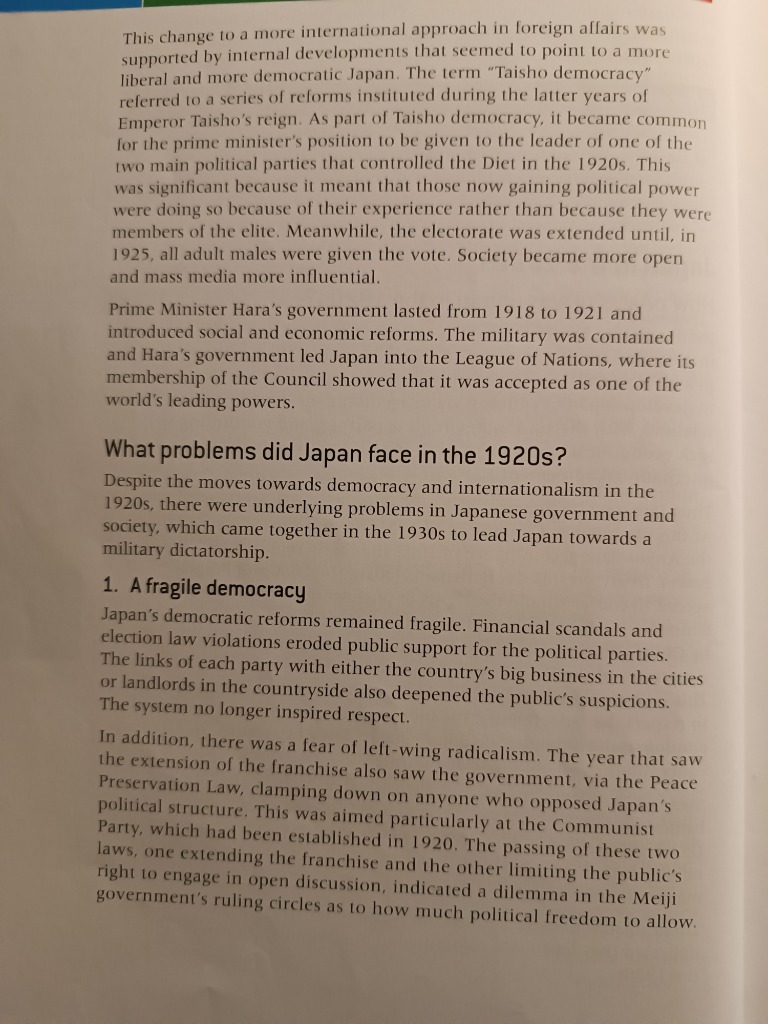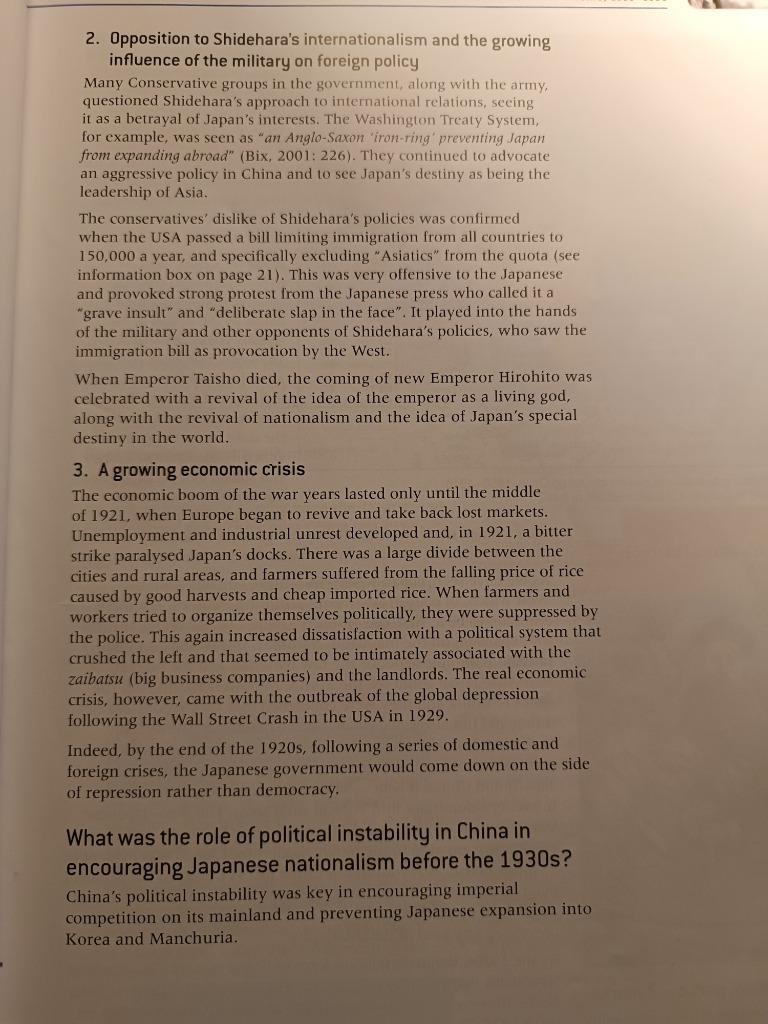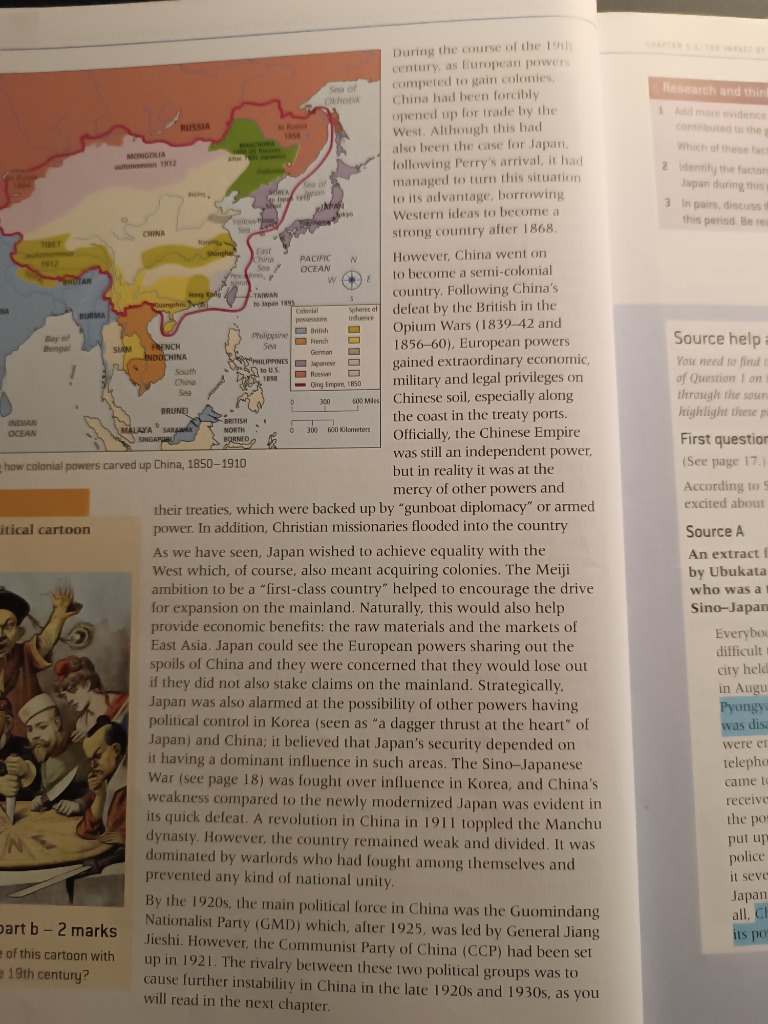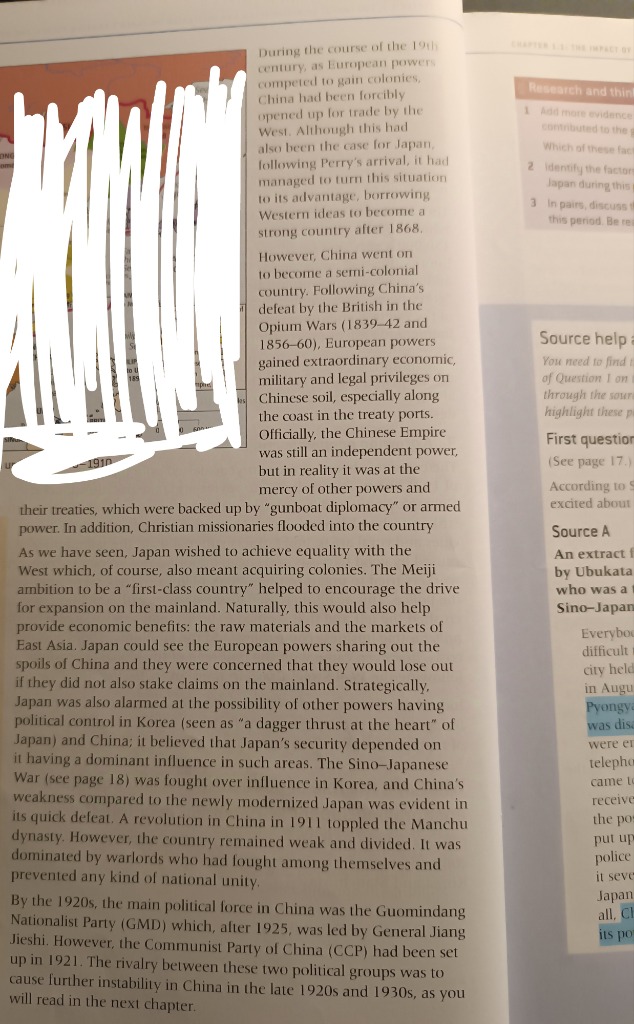History of japan 1920'
Japan's Political Landscape in the 1920s

Taisho Democracy
- Definition: Refers to a series of reforms during Emperor Taisho's reign that aimed to liberalize and democratize Japan.
- Significance: The reforms included giving the prime minister's position to the leader of one of the main political parties, indicating a move towards governance based on experience rather than elite background.
- Impact on Society: Extended voting rights to all adult males by 1925 and made the society more engaged with mass media, leading to greater political awareness.
Hara's Government (1918-1921)
- Reforms: Introduced social and economic reforms aimed at stabilizing the government.
- International Relations: Contained military influence and facilitated Japan's entry into the League of Nations, showing its acceptance among world powers.
Challenges Faced in the 1920s
-
Fragile Democracy
- Issues: Financial scandals and election law violations weakened public trust in political parties.
- Public Sentiment: The public's suspicion was directed particularly towards collaborations between big businesses in urban areas and landlords in the countryside.
- Lack of Respect: Political systems and parties no longer commanded respect, leading to a disconnect between the government and the populace.
-
Fear of Left-Wing Radicalism
- Legislation: The government passed laws in the same year that extended voting rights and imposed restrictions against the Communist Party.
- Peace Preservation Law: This law targeted opposition groups, reflecting the government’s anxiety about leftist ideologies and their potential to disrupt the political atmosphere.
- Public Discourse: New laws limiting open discussion highlighted a struggle within the government regarding how much political freedom to allow, creating tension in Meiji government's ruling circles.
Extended readings:
Notes on Opposition to Shidehara’s Foreign Policy and Economic Crisis in Japan

Opposition to Shidehara’s Internationalism
-
Conservative Opposition: Many conservative groups, including the military, were against Shidehara’s approach to international relations.
- Thoughts: This reflects a significant divide in Japanese politics during this period, highlighting the tension between more progressive internationalist policies and nationalist perspectives.
- Additional Information: Shidehara's policies were seen as a betrayal of Japan's national interests, leading to criticism from nationalist factions.
-
Washington Treaty System: It was perceived as an "Anglo-Saxon iron-ring" restricting Japan's expansion abroad.
- Thoughts: This perception foreshadowed Japan's later aggressive foreign policy actions in Asia as a reaction to these treaties.
-
Immigration Act of 1921: This act limited immigration, particularly targeting individuals from Asian regions, which was viewed as an insult by many Japanese.
- Thoughts: The exclusionary nature of the law could be seen as a catalyst for rising Japanese nationalism and resentment toward Western powers.
-
Emperor Taisho’s Death: The shift to Emperor Hirohito represented a return to an era where the emperor was viewed as a living god.
- Thoughts: This change could indicate a reinvigoration of nationalist sentiments and traditional values in Japan.
Growing Economic Crisis
-
Post-World War I Economic Environment: In 1921, with Europe's recovery, Japan faced a harsh economic reality.
- Thoughts: The disconnection between urban centers and rural areas represented deep socio-economic divides that can lead to political instability.
-
Unemployment and Industrial Unrest: A notable strike in 1921 paralyzed Japan’s docks and increased dissatisfaction among workers.
- Additional Information: The unrest showcased the challenges of rapid modernization and industrialization without corresponding social reforms.
-
Farmers’ Struggles: Falling rice prices hurt farmers financially, further straining the economy.
- Thoughts: Agricultural distress often leads to wider societal discontent, making it a significant factor in political uprisings.
-
Policy Suppression: Political organization attempts by workers were met with suppression by the police.
- Thoughts: This indicates a retreat from democratic governance and could lead to increased radicalization among the populace.
-
Impact of the Global Depression: The 1929 Wall Street Crash exacerbated Japan's economic issues, leading to increased government repression.
- Thoughts: Global economic interdependence meant that foreign crises could drastically affect domestic policies and stability.
Political Instability in China
-
Role in Japanese Nationalism: Political instability in China encouraged Japan's imperial pursuits on the Asian mainland.
- Thoughts: Such instability often leads stronger nations to capitalize on weaker neighbors, justifying expansionist policies under the guise of protection or stability.
-
Preventing Expansion into Korea and Manchuria: China's instability was crucial to refraining Japanese expansionism in this region, which would later be a focal point for conflict.
- Additional Information: Understanding this context is vital for analyzing Japan's territorial ambitions during the early 20th century.
Extended readings:
Notes on the Historical Context of China and Japan in the 19th Century

-
Colonial Competition and Trade
- European powers, including Britain, were competing for colonies in the 19th century.
- China was significantly affected as it was forcibly opened up for trade.
- The East India Company played a crucial role, particularly through the Opium Wars, leading to significant territorial and economic concessions.
-
Japan's Response to Western Influence
- Japan sought to turn threats from Western powers into opportunities for modernization.
- Following Commodore Perry's arrival, Japan adopted Western ideas and technology post-1868, becoming a strong nation.
- The Meiji Restoration was pivotal in this transformation, emphasizing the need for Japan to achieve equality with Western nations.
-
Impact of the Opium Wars on China
- China experienced severe defeats during the Opium Wars (1839-42 and 1856-60) at the hands of British forces.
- The consequence was the imposition of unequal treaties, granting European powers economic control over key ports and territories.
- China's sovereignty was undermined, turning the nation into a semi-colonial state, much to the dismay of its ruling elite.
-
Political Turmoil in China
- The Qing Dynasty struggled to maintain control amid internal and external pressures.
- Christian missionaries expanded their influence in China, complicating the socio-political landscape.
- A revolution in 1911 led to the downfall of the Qing Dynasty but the nation remained fractured, facing divisions among warlords.
-
Rise of Political Movements
- The Nationalist Party (Guomindang or GMD), led by General Jiang Jieshi, emerged to fill the political void after the Qing.
- The Chinese Communist Party (CCP) was established in 1921, creating a rivalry that would shape China's future.
- The conflict between the GMD and CCP highlights the lack of national unity and persistent ideological struggles during this period.
-
Concerns Over Regional Influences
- Japan viewed Chinese instability as a threat, especially regarding influence in Korea.
- The Sino-Japanese War not only showcased Japan’s growing power but also reflected China's vulnerabilities.
- Both nations were often influenced by the maneuvers of Western powers in the region, which complicated their relations and strategies.
Extended readings:
Notes on the 19th Century Colonial Dynamics in East Asia

-
Colonization and Trade in China
- During the 19th century, European powers competed for colonies and forced China to open its trade.
- Thoughts: This reflects the wider imperialistic tendencies of the era, where Western nations sought to expand their influence globally, often at the expense of local sovereignty.
- Additional Info: The Opium Wars were central to this, as they forced China to trade opium, leading to widespread addiction and socioeconomic issues.
-
China's Semi-Colonial Status
- After losing the Opium Wars, China became semi-colonial, with foreign powers gaining significant privileges.
- Thoughts: This semi-colonial status illustrates how weakened states can become subject to foreign exploitation while maintaining a facade of sovereignty.
- Additional Info: This situation led to the Treaty of Nanjing and other unequal treaties, further undermining China's autonomy.
-
Japan's Response to Western Influence
- Japan, on the other hand, adapted and became a strong nation after 1868 by borrowing Western ideas.
- Thoughts: This contrast between Japan and China highlights differing national responses to external pressures; Japan's modernization contrasts sharply with China's decline during this period.
- Additional Info: The Meiji Restoration was instrumental in Japan's transformation into a modern state.
-
Korean Peninsula Dynamics
- Japan viewed Korean control as crucial for its security and influence in the region.
- Thoughts: This understanding of regional geopolitics indicates Japan's early imperial ambitions and fear of foreign interference.
- Additional Info: The Sino-Japanese War (1894-95) was significant as it marked Japan's emergence as a regional power.
-
Political Turmoil in China
- By the 1920s, the Guomindang (Nationalist Party) and the Communist Party (CCP) became the main political forces in China.
- Thoughts: The rivalry between these two parties set the stage for subsequent civil strife and revolutions that would shape modern Chinese history.
- Additional Info: The split between the Nationalists and Communists led to the Chinese Civil War, dramatically impacting China’s political landscape and future.
-
Impact of Foreign Powers
- Foreign intervention and influence severely weakened China's national identity and unity.
- Thoughts: This is a lesson in how external pressures can manipulate internal politics and provoke civil conflict, undermining national cohesion.
- Additional Info: Nationalism grew as a response to foreign exploitation, eventually leading to movements aimed at restoring sovereignty.
These notes summarize key points from the image, emphasizing the significant geopolitical shifts in East Asia during the 19th century, particularly the contrasting paths of China and Japan in the face of Western imperialism.
Extended readings: